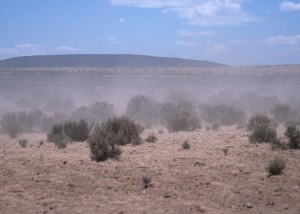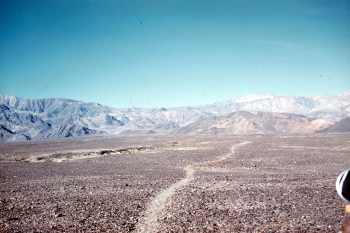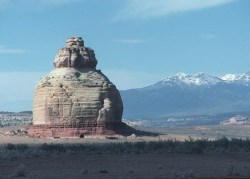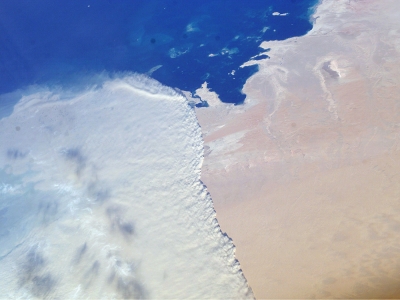20.1: Eolian Processes
- Page ID
- 17309
\( \newcommand{\vecs}[1]{\overset { \scriptstyle \rightharpoonup} {\mathbf{#1}} } \)
\( \newcommand{\vecd}[1]{\overset{-\!-\!\rightharpoonup}{\vphantom{a}\smash {#1}}} \)
\( \newcommand{\dsum}{\displaystyle\sum\limits} \)
\( \newcommand{\dint}{\displaystyle\int\limits} \)
\( \newcommand{\dlim}{\displaystyle\lim\limits} \)
\( \newcommand{\id}{\mathrm{id}}\) \( \newcommand{\Span}{\mathrm{span}}\)
( \newcommand{\kernel}{\mathrm{null}\,}\) \( \newcommand{\range}{\mathrm{range}\,}\)
\( \newcommand{\RealPart}{\mathrm{Re}}\) \( \newcommand{\ImaginaryPart}{\mathrm{Im}}\)
\( \newcommand{\Argument}{\mathrm{Arg}}\) \( \newcommand{\norm}[1]{\| #1 \|}\)
\( \newcommand{\inner}[2]{\langle #1, #2 \rangle}\)
\( \newcommand{\Span}{\mathrm{span}}\)
\( \newcommand{\id}{\mathrm{id}}\)
\( \newcommand{\Span}{\mathrm{span}}\)
\( \newcommand{\kernel}{\mathrm{null}\,}\)
\( \newcommand{\range}{\mathrm{range}\,}\)
\( \newcommand{\RealPart}{\mathrm{Re}}\)
\( \newcommand{\ImaginaryPart}{\mathrm{Im}}\)
\( \newcommand{\Argument}{\mathrm{Arg}}\)
\( \newcommand{\norm}[1]{\| #1 \|}\)
\( \newcommand{\inner}[2]{\langle #1, #2 \rangle}\)
\( \newcommand{\Span}{\mathrm{span}}\) \( \newcommand{\AA}{\unicode[.8,0]{x212B}}\)
\( \newcommand{\vectorA}[1]{\vec{#1}} % arrow\)
\( \newcommand{\vectorAt}[1]{\vec{\text{#1}}} % arrow\)
\( \newcommand{\vectorB}[1]{\overset { \scriptstyle \rightharpoonup} {\mathbf{#1}} } \)
\( \newcommand{\vectorC}[1]{\textbf{#1}} \)
\( \newcommand{\vectorD}[1]{\overrightarrow{#1}} \)
\( \newcommand{\vectorDt}[1]{\overrightarrow{\text{#1}}} \)
\( \newcommand{\vectE}[1]{\overset{-\!-\!\rightharpoonup}{\vphantom{a}\smash{\mathbf {#1}}}} \)
\( \newcommand{\vecs}[1]{\overset { \scriptstyle \rightharpoonup} {\mathbf{#1}} } \)
\( \newcommand{\vecd}[1]{\overset{-\!-\!\rightharpoonup}{\vphantom{a}\smash {#1}}} \)
\(\newcommand{\avec}{\mathbf a}\) \(\newcommand{\bvec}{\mathbf b}\) \(\newcommand{\cvec}{\mathbf c}\) \(\newcommand{\dvec}{\mathbf d}\) \(\newcommand{\dtil}{\widetilde{\mathbf d}}\) \(\newcommand{\evec}{\mathbf e}\) \(\newcommand{\fvec}{\mathbf f}\) \(\newcommand{\nvec}{\mathbf n}\) \(\newcommand{\pvec}{\mathbf p}\) \(\newcommand{\qvec}{\mathbf q}\) \(\newcommand{\svec}{\mathbf s}\) \(\newcommand{\tvec}{\mathbf t}\) \(\newcommand{\uvec}{\mathbf u}\) \(\newcommand{\vvec}{\mathbf v}\) \(\newcommand{\wvec}{\mathbf w}\) \(\newcommand{\xvec}{\mathbf x}\) \(\newcommand{\yvec}{\mathbf y}\) \(\newcommand{\zvec}{\mathbf z}\) \(\newcommand{\rvec}{\mathbf r}\) \(\newcommand{\mvec}{\mathbf m}\) \(\newcommand{\zerovec}{\mathbf 0}\) \(\newcommand{\onevec}{\mathbf 1}\) \(\newcommand{\real}{\mathbb R}\) \(\newcommand{\twovec}[2]{\left[\begin{array}{r}#1 \\ #2 \end{array}\right]}\) \(\newcommand{\ctwovec}[2]{\left[\begin{array}{c}#1 \\ #2 \end{array}\right]}\) \(\newcommand{\threevec}[3]{\left[\begin{array}{r}#1 \\ #2 \\ #3 \end{array}\right]}\) \(\newcommand{\cthreevec}[3]{\left[\begin{array}{c}#1 \\ #2 \\ #3 \end{array}\right]}\) \(\newcommand{\fourvec}[4]{\left[\begin{array}{r}#1 \\ #2 \\ #3 \\ #4 \end{array}\right]}\) \(\newcommand{\cfourvec}[4]{\left[\begin{array}{c}#1 \\ #2 \\ #3 \\ #4 \end{array}\right]}\) \(\newcommand{\fivevec}[5]{\left[\begin{array}{r}#1 \\ #2 \\ #3 \\ #4 \\ #5 \\ \end{array}\right]}\) \(\newcommand{\cfivevec}[5]{\left[\begin{array}{c}#1 \\ #2 \\ #3 \\ #4 \\ #5 \\ \end{array}\right]}\) \(\newcommand{\mattwo}[4]{\left[\begin{array}{rr}#1 \amp #2 \\ #3 \amp #4 \\ \end{array}\right]}\) \(\newcommand{\laspan}[1]{\text{Span}\{#1\}}\) \(\newcommand{\bcal}{\cal B}\) \(\newcommand{\ccal}{\cal C}\) \(\newcommand{\scal}{\cal S}\) \(\newcommand{\wcal}{\cal W}\) \(\newcommand{\ecal}{\cal E}\) \(\newcommand{\coords}[2]{\left\{#1\right\}_{#2}}\) \(\newcommand{\gray}[1]{\color{gray}{#1}}\) \(\newcommand{\lgray}[1]{\color{lightgray}{#1}}\) \(\newcommand{\rank}{\operatorname{rank}}\) \(\newcommand{\row}{\text{Row}}\) \(\newcommand{\col}{\text{Col}}\) \(\renewcommand{\row}{\text{Row}}\) \(\newcommand{\nul}{\text{Nul}}\) \(\newcommand{\var}{\text{Var}}\) \(\newcommand{\corr}{\text{corr}}\) \(\newcommand{\len}[1]{\left|#1\right|}\) \(\newcommand{\bbar}{\overline{\bvec}}\) \(\newcommand{\bhat}{\widehat{\bvec}}\) \(\newcommand{\bperp}{\bvec^\perp}\) \(\newcommand{\xhat}{\widehat{\xvec}}\) \(\newcommand{\vhat}{\widehat{\vvec}}\) \(\newcommand{\uhat}{\widehat{\uvec}}\) \(\newcommand{\what}{\widehat{\wvec}}\) \(\newcommand{\Sighat}{\widehat{\Sigma}}\) \(\newcommand{\lt}{<}\) \(\newcommand{\gt}{>}\) \(\newcommand{\amp}{&}\) \(\definecolor{fillinmathshade}{gray}{0.9}\)Eolian processes are most effective where surface material is fine, dry and loose. Vegetation imposes a frictional force on the wind to reduce its effectiveness. Thus, an environment devoid of vegetation is best. These conditions are met in deserts found on every continent of the world. In most cases, wind erosion predominates over deposition leaving a surface of stones. Only one quarter of Earth's deserts are partially or completely covered by sand.

Though less extensive in area, coastlines of large bodies of water are another eolian environment. Here, waves and currents supply weathered material susceptible to wind action.
Eolian processes have been enhanced by human activity over the past few centuries, especially in Asia and Africa. Overuse of soil and grazing land resources in semi-arid and arid and seasonally dry regions has led to extensive wind erosion and desertification.
Wind Erosion
The entire solid surface of the Earth is subject to wind erosion. It is the balance between the driving force of the wind and the resistance of the surface that ultimately determines whether surface materials are detached and transported away.
Factors affecting wind erosion
The ability of the wind to erode the surface is determined by two factors, air density and wind velocity. The erosive power of the wind (E) is given as:
\[E\,=\,V^3\rho\]
where V = wind velocity, and \(\rho\) = air density. Density has relatively little impact on the power of the wind. The erosive force of the wind is primarily related to its velocity. Its importance is seen as erosive power varies with the third power of velocity. For instance, a doubling of the wind velocity increases the erosive power by 8 fold while a tripling of velocity produces a 27 fold increase.

The roughness length of the surface (z0), a parameter based on the size and distance between objects in a group, has a critical control over the velocity of the wind. Grass, shrubs, and trees, all impart a drag on the wind to reduce its erosive force. Vegetation also acts to bind soil particles to the surface. A surface without a cover of vegetation exposes soil to the direct force of the wind making erosion more effective. Thus, dry regions lacking a protective cover of vegetation display the effects of wind erosion more than humid climates.
|
Type of Surface |
zo(cm) |
|---|---|
|
Fir Forest |
283.0 |
|
Citrus Orchard |
198.0 |
|
Large City (Tokyo) |
165 |
|
Corn Field |
84.5 |
|
Wheat Field |
23.0 |
|
Grass |
10.0 |
|
Dry Lake Bed |
0.003 |
The cohesiveness of surface materials affects the resistance of the surface to erosion. Clay particles exhibit a greater degree of cohesiveness than sand. Clay-rich soils tend to resist erosion by wind more than less cohesive materials. Thus, clays require a much higher threshold velocity for detachment than one would expect. Cohesiveness may be provided by a cementing agent as well. Calcium carbonate and other salts common to desert regions deposited in interparticle voids harden and bind particles together.
Features of wind erosion
Landscapes formed from the work of wind result from either the removal of fine particles, or the sculpting effects of material in movement. Deflation lifts and removes loose particles from the surface. Deserts where soils of mixed particle size have been eroded of fines leave a cobblestone-like surface behind called desert lag or desert pavement.The interlocking pavement of stones protects the underlying surface from the wind. If disturbed, the surface becomes subject to erosion. Such has been the result of surface degradation from military activities in the desert regions of North Africa during World War II (as well as later conflicts fought in the desert regions of the Middle East).

Deflation may also result in blowout depressions, basins ranging in size from less than a meter to many meters deep. Chemical weathering of cementing materials loosens particles cohesiveness to enable wind erosion. Some extremely large depressions like the Qattara Depression in the western desert of Egypt are partially a result of deflation.

Sand particles lifted free of the surface can "sand blast" rock surfaces in a process called abrasion. Abrasion shapes and polishes exposed bedrock. Abrasion is restricted to a distance of about a meter or two above the surface because sand grains are lifted a short distance. Ventifacts are smooth faceted rocks that often have a polished surface that results from abrasion. At a much larger scale, elongate ridges called yardangs form by the abrasion and streamlining rock structures oriented parallel to the prevailing wind direction. Abrasion occurs at the windward end while deflation removes material from the leeward end. Archaeologists have suggested that the Great Sphinx of Giza, Egypt is partially formed from a yardang.
Sand transport
Much of our knowledge about sand transport dates back to the 1930s and 1940s when British Brigadier Ralph A. Bagnold conducted experiments while stationed in the desert of North Africa. Sand generally begins to move when the wind achieves a velocity of about 4.5 m/sec. At first, sand exhibits a rolling motion called traction or surface creep. Approximately 20 to 25% of total sand transport during sand storms occurs by traction. As wind speed increases, grains are lifted into the air by wind gusts.

Once airborne, sand grains travel downwind and then drop back to the surface several centimeters from their point of origin. Finer dust particles are lifted from the surface and suspended in the air at much greater heights than heavier sand grains. With strong winds and turbulence, sand grains can be lifted as high as 2 meters and travel a distance of 10 meters or more. When a settling sand grain impacts the surface, it sends another grain of sand into the air to travel in the downwind direction. Watching this process in action makes sand appear to be bouncing along the surface. We call this process saltation which accounts for 75% to 80% of sand transport over sand dunes. Once saltation begins, transport can continue under somewhat lower wind speeds.
Dust storms are primarily composed of fine material that easily reduce visibilities to a few meters and can persist for hours. During a prolonged dry period, extraordinary amounts of valuable top soil was stripped from the Great Plains during the "Dust Bowl" period of the 1930s. Moister conditions returned and the application of soil conservation techniques have greatly reduced the erosive effects of wind. Sand storms are raging systems of blowing, stinging sand traveling a meter or two above the surface.

A strange phenomena that has mystified generations is the sound moving sand can make as it is transported across the surface. In approximately 30 places around the world, a sustained hum rings out from this resonating dunes when wind conditions are right. Geoscientist have long wondered what causes "booming dunes". [View "Booming Dunes" from NOVA scienceNow].


